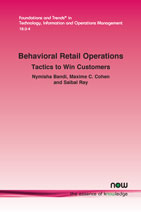Behavioral Retail Operations: Tactics to Win Customers
By Nymisha Bandi, McGill University, Canada, nymisha.bandi@mail.mcgill.ca | Maxime C. Cohen, McGill University, Canada, maxime.cohen@mcgill.ca | Saibal Ray, McGill University, Canada, saibal.ray@mcgill.ca
Abstract
Shoppers face numerous decisions about which products to purchase, as the number of available options grows. To navigate this complexity, retailers deploy a range of tactics aimed at influencing customer behavior and guiding them toward specific purchases. Understanding customer behavior in both online and brick-and-mortar settings requires an understanding of customer psychology, including the factors that drive purchase decisions and responses to promotions. Retailers strategically use data to analyze patterns and employ tools from business analytics and machine learning to identify key influences on shopping behavior. These insights often rely on detailed consumer information, such as demographics, historical purchases, and reactions to past promotions, alongside broader social, cultural, and psychological factors. In this monograph, we reviewed decades of research on retail tactics used to influence consumer choices, focusing on price, promotion, and place. We examined the nuances of pricing strategies, including psychological effects, framing techniques, and price perception, as well as in-store promotions and design strategies that shape the shopping environment. Additionally, we explored digital retail tactics such as web design, product recommendations, and user ratings. Our goal was to connect research with practical strategies, providing a comprehensive review and suggesting future research directions at the intersection of consumer psychology and retail strategy.
Behavioral Retail Operations: Tactics to Win Customers
In today’s fast-paced retail world, consumers face an overwhelming array of product choices, and retailers are constantly seeking new ways to steer their purchasing decisions. Behavioral Retail Operations: Tactics to Win Customers delves into the intricate relationship between consumer psychology and strategic retail tactics. Drawing on decades of research, the authors explore how factors such as pricing, promotions, and store layout influence shopper behavior in both physical and online settings. From understanding the subtle psychological effects of price framing to uncovering how sensory elements like music and color shape the shopping experience, this monograph provides a comprehensive look at the tools retailers use to maximize profitability. Offering a deep dive into the art of influencing consumer behavior, this monograph is essential for both researchers and practitioners aiming to bridge the gap between theory and real-world retail strategy.
